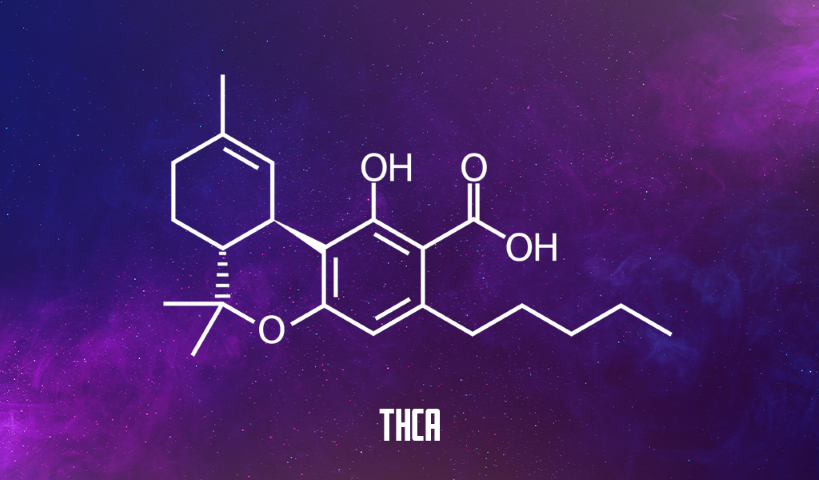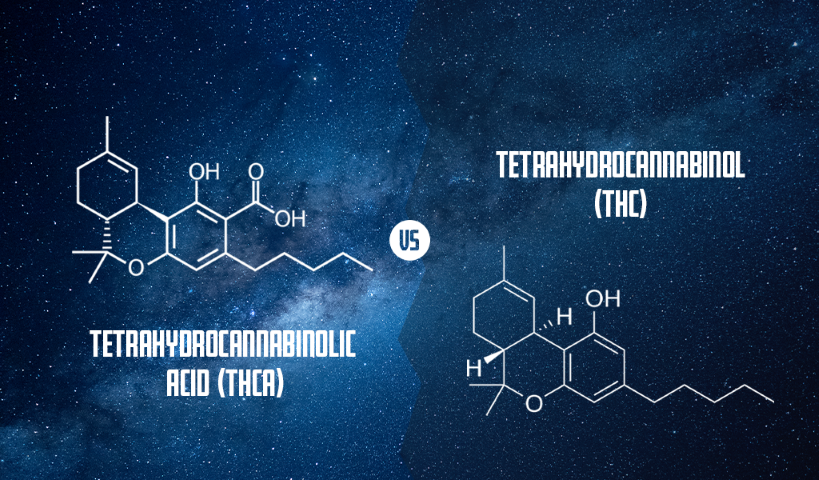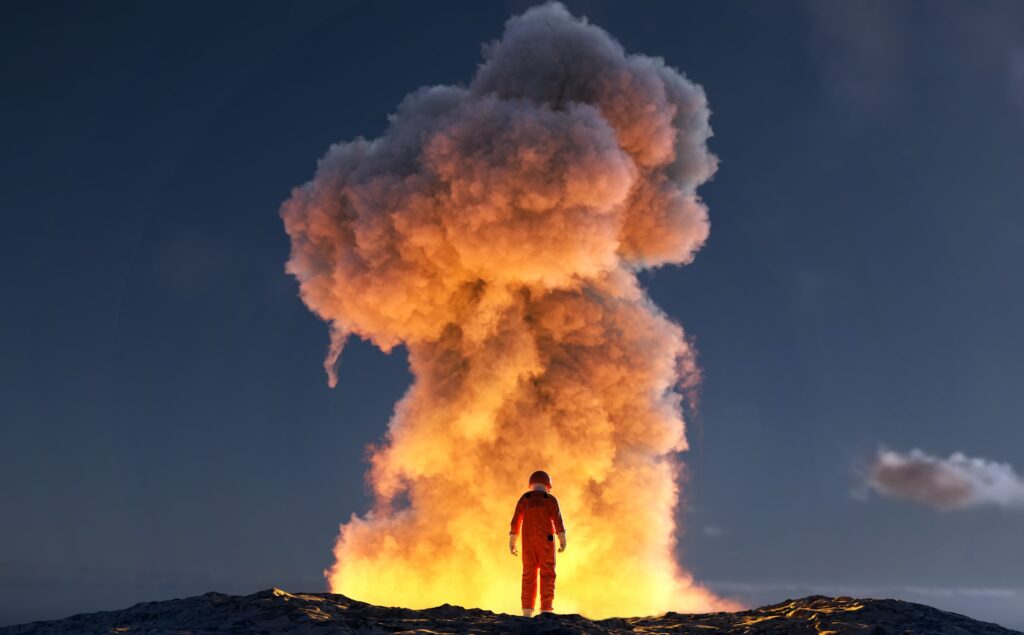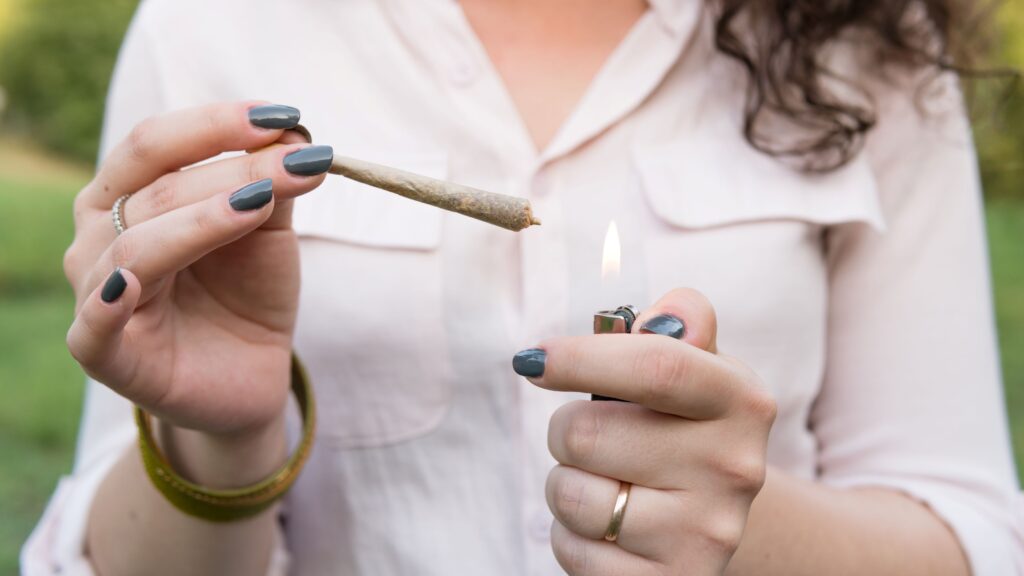Cannabis, with its rich tapestry of compounds, has long been a subject of fascination and exploration.
Among the many cannabinoids found within the plant, Tetrahydrocannabinolic Acid, or THCA, stands as a precursor to one of the most well-known and researched components of cannabis—Tetrahydrocannabinol (THC).
In this article, we delve into the fascinating world of THCA, unraveling the science behind its formation, its interaction with the human body’s endocannabinoid system, and the potential therapeutic avenues it may open. Join us as we navigate the complex terrain of cannabinoids and uncover the secrets of how THCA operates within the cannabis matrix, offering not only a deeper understanding of the plant but also insights into its possible therapeutic applications and similar effects to THC.

What is THCA?
THCA, or Tetrahydrocannabinolic Acid, is a cannabinoid that is found in the raw, unprocessed cannabis plant. It is the acidic precursor to THC (Tetrahydrocannabinol), the compound responsible for the psychoactive effects commonly associated with cannabis consumption.
In its natural state, cannabis plants produce THCA rather than THC. The conversion from THCA to THC occurs through a process called decarboxylation, which involves the application of heat. When cannabis is heated through methods such as smoking, vaping, or cooking, THCA loses a carboxyl group and transforms into THC, unlocking its psychoactive properties.
Research on THCA is ongoing, and scientists are exploring its potential anti-inflammatory, neuroprotective, and antiemetic (anti-nausea) properties. As interest in the medicinal aspects of cannabis grows, so does the attention given to cannabinoids like THCA, highlighting its importance in the broader spectrum of cannabis chemistry.

How are THC and THCA Different?
The main difference between THC and THCA lies in their properties and effects. THC is the well-known psychoactive compound responsible for the “high” associated with cannabis use. It produces euphoria, altered perception, and relaxation. On the other hand, THCA must be transformed into THC in order to achieve the same desired effects, which Moonwlkr has achieved. The transformation from THCA to THC occurs through a process called decarboxylation, typically activated by heat. Once this transformation takes place, cannabis users are able to enjoy the effects of THC with THC’s more widely legalized cousin THCA.
Still curious about the comparison? Check out our in-depth analysis of THCA vs Delta-9 THC!
How is THCA Formed?
THCA (Tetrahydrocannabinolic Acid) is formed through a biosynthetic process within the trichomes of the cannabis plant, which are the resinous glands found on the surface of the flowers and leaves. The biosynthesis of THCA involves several steps:
1. Geranyl Pyrophosphate (GPP) Formation:
The journey of creating THCA starts with making something called geranyl pyrophosphate. Think of it as a building block for many cannabinoids. To make it, two smaller parts – isopentenyl pyrophosphate (IPP) and dimethylallyl pyrophosphate (DMAPP) – come together. They’re like the ingredients needed to start building geranyl pyrophosphate.
2. Cannabigerolic Acid (CBGA) Formation:
Geranyl pyrophosphate is then combined with olivetolic acid, leading to the formation of cannabigerolic acid (CBGA). CBGA is considered the precursor to many cannabinoids, including THCA.
3. Enzymatic Transformation into THCA:
The enzyme THCA synthase acts on CBGA to convert it into CBDA (Cannabidiolic Acid) and THCA. THCA is the precursor to THCA, while CBDA is the precursor to CBD-A (Cannabidiolic Acid).
4. Decarboxylation:
Decarboxylation is like unlocking a special power in cannabis. When you have raw cannabis, it contains compounds like THCA, which doesn’t make you feel high. But, if you want that classic cannabis high, you need to activate or “unlock” THCA. That’s where decarboxylation comes in.
Imagine THCA as a superhero in disguise, and decarboxylation is the process that reveals its superpowers. It happens when you apply heat to cannabis, like when you light it up, vape it, or cook it. The heat makes THCA lose a small part (a carboxyl group), transforming into THC – the compound that gives you the psychoactive effects and that familiar high. So, decarboxylation is like turning on the superpowers of THCA to get the full experience from your cannabis. Gain further knowledge about how THCA converts to Delta-9 THC here!

How does THCA react with the Endocannabinoid System
THCA interacts with the Endocannabinoid System (ECS), a complex cell-signaling system in the human body that plays a crucial role in regulating various physiological processes. Unlike its derivative, THC, THCA before decarboxylation, does not directly bind to the CB1 receptors in the brain responsible for the psychoactive effects commonly associated with cannabis.
Research on THCA and the ECS is still in its early stages, but it is believed that THCA in its natural state might influence the ECS indirectly. Some studies suggest that THCA interacts with other receptors, enzymes, or signaling pathways within the ECS, contributing to its potential therapeutic effects.
It’s important to note that the ECS is involved in maintaining homeostasis, which is the balance of internal conditions necessary for the optimal functioning of the body. Raw THCA may have a unique impact on the ECS, potentially influencing processes such as inflammation, immune response, and neuroprotection. However, more research is needed to fully understand the specific mechanisms of THCA interaction with the ECS and its potential therapeutic applications.
Are there Therapeutic Benefits to THCA?
Emerging research suggests that THCA (Tetrahydrocannabinolic Acid) may offer a range of therapeutic effects. While still in the early stages of investigation, THCA is being explored for its potential anti-inflammatory, neuroprotective, and antiemetic (anti-nausea) properties. Preliminary findings indicate that THCA may have promise in alleviating conditions such as chronic pain, autoimmune disorders, and neurodegenerative diseases. However, further research is essential to comprehensively understand the therapeutic potential of THCA and its specific mechanisms of action within the human body. For more possible benefits of THCA check out this article.
Methods of Consumption for THCA
There are various methods for consuming THCA, each offering distinct advantages and considerations: When cannabis is heated through processes like smoking, vaping, or baking, THCA undergoes decarboxylation, converting into THC and becoming psychoactive.
1. THCA Flower
The most common and simple method of cannabis consumption is flower. THCA flower can be smoked within your favorite vessel. Once heated, THCA will provide the familiar effects THC typically offers.
Read our guide for further information about what to look for in a THCA Pre-roll! You can also learn more about the safety of THCA flower here!
2. THCA Vapes
Vapes offer a great and discreet alternative to smoking flower. The heating element within a vape allows for the THCA product within to be heated to the necessary temperature to induce the effects brought on by the decarboxylation process.
3. THCA Edibles
Cooking or incorporating THCA into recipes might be appealing for those who prefer an edible option. Some places may offer gummies as a form of an edible. The heat needed to remove the carboxyl group from the molecular structure in THCA can be achieved over time with heat applied when cooking or baking unlocking THCA’s psychoactive properties.
How Does THCA Work?
In our journey through the world of cannabis, we’ve uncovered the potential of THCA, a compound with its own unique qualities.
We’ve learned how THCA forms in the cannabis plant and how it transforms into active THC through a process called decarboxylation. This unlocks its potential therapeutic and psychoactive effects. Whether you prefer smoking, cooking, or other methods, there are various ways to tap into the benefits of THCA.
As research continues, we’re beginning to see that THCA might have anti-inflammatory and neuroprotective properties. It’s an exciting time as we bridge ancient cannabis wisdom with modern scientific discovery.
Remember that cannabis is a complex plant with much still to be discovered. With THCA at the forefront of discussions on cannabis medicine, staying curious and informed will be key.
As the journey continues, we anticipate more insights into the potential benefits of THCA, adding another chapter to the evolving story of cannabis.





